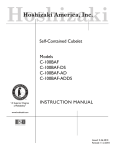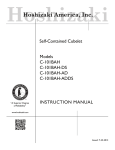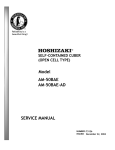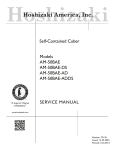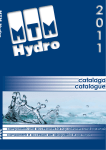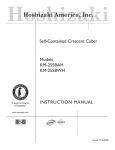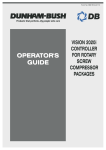Download Hoshizaki AM-50BAE-ADDS Ice Maker User Manual
Transcript
Hoshizaki Hoshizaki America, Inc. Self-Contained Cuber Models AM-50BAE AM-50BAE-DS AM-50BAE-AD AM-50BAE-ADDS “A Superior Degree of Reliability” INSTRUCTION MANUAL www.hoshizaki.com Issued: 3-10-2006 Revised: 7-1-2011 IMPORTANT Only qualified service technicians should install, service, or maintain the icemaker. No installation, service, or maintenance should be undertaken until the technician has thoroughly read this Instruction Manual. Likewise, the owner/ manager should not proceed to operate the icemaker until the installer has instructed them on its proper operation. Failure to install, operate, and maintain the equipment in accordance with this manual may adversely affect safety, performance, component life, and warranty coverage. Hoshizaki provides this manual primarily to assist qualified service technicians in the installation, maintenance, and service of the icemaker. Should the reader have any questions or concerns which have not been satisfactorily addressed, please call, write, or send an e-mail message to the Hoshizaki Technical Support Department for assistance. HOSHIZAKI AMERICA, INC. 618 Highway 74 South Peachtree City, GA 30269 Attn: Hoshizaki Technical Support Department Phone: 1-800-233-1940 Technical Support (770) 487-2331 Fax:1-800-843-1056 (770) 487-3360 E-mail: [email protected] Web Site: www.hoshizaki.com NOTE: To expedite assistance, all correspondence/communication MUST include the following information: • Model Number • Serial Number • Complete and detailed explanation of the problem. 2 IMPORTANT This manual should be read carefully before the icemaker is installed and operated. Only qualified service technicians should install, service, and maintain the icemaker. Read the warnings contained in this booklet carefully as they give important information regarding safety. Please retain this booklet for any further reference that may be necessary. CONTENTS Important Safety Information.................................................................................................. 4 I. Specifications....................................................................................................................... 5 A. Construction................................................................................................................... 5 B. Electrical Data................................................................................................................ 6 C. Dimensions/Connections............................................................................................... 7 1. AM-50BAE................................................................................................................. 7 2. AM-50BAE-DS........................................................................................................... 8 3. AM-50BAE-AD........................................................................................................... 9 4. AM-50BAE-ADDS.................................................................................................... 10 II. Installation and Operating Instructions..............................................................................11 A. Checks Before Installation.............................................................................................11 B. Location.........................................................................................................................11 1. General.....................................................................................................................11 2. Built-In Installation Site............................................................................................ 12 C. Door............................................................................................................................. 13 1. AM-50BAE, AM-50BAE-AD...................................................................................... 13 a) Hinge Reversal................................................................................................... 13 2. AM-50BAE-DS, AM-50BAE-ADDS.......................................................................... 15 a) Overlay Panel Fabrication and Attachment......................................................... 15 D. Setup............................................................................................................................ 23 E. Electrical Connection................................................................................................... 23 F. Water Supply and Drain Connections........................................................................... 24 G. Final Checklist ............................................................................................................ 25 H. Startup......................................................................................................................... 26 III. Cleaning and Maintenance.............................................................................................. 27 A. Cleaning and Sanitizing Instructions............................................................................ 27 1. Cleaning Solution..................................................................................................... 27 2. Cleaning Procedure................................................................................................. 27 3. Sanitizing Solution................................................................................................... 29 4. Sanitizing Procedure................................................................................................ 29 B. Maintenance................................................................................................................. 32 C. Preparing the Icemaker for Long Storage.................................................................... 33 3 Important Safety Information Throughout this manual, notices appear to bring your attention to situations which could result in death, serious injury, or damage to the unit. WARNING Indicates a hazardous situation which could result in death or serious injury. CAUTION Indicates a situation which could result in damage to the unit. IMPORTANT Indicates important information about the use and care of the unit. WARNING This icemaker should be destined only to the use for which it has been expressly conceived. Any other use should be considered improper and therefore dangerous. The manufacturer cannot be held responsible for injury or damage resulting from improper, incorrect, and unreasonable use. To reduce the risk of death, electric shock, serious injury, or fire, follow basic precautions including the following: • This unit requires an independent power supply. See the nameplate for proper voltage and breaker/fuse size. Failure to use a proper breaker or fuse can result in a tripped breaker, blown fuse, or damage to existing wiring. This could lead to heat generation or fire. • THIS UNIT MUST BE GROUNDED: This unit is equipped with a 3‑prong grounding plug to reduce the risk of potential shock hazards. It must be plugged into a properly grounded, independent wall outlet. If the outlet is a 2-prong outlet, it is your personal responsibility to have a qualified electrician replace it with a properly grounded, independent 3-prong wall outlet. Do not remove the ground prong from the power cord and do not use an adapter plug. • Do not use an extension cord. • Make sure the control switch is in the "OFF" position before plugging in or unplugging the unit to reduce the risk of electric shock. • Do not use a unit with a damaged power cord. The power cord should not be altered, jerked, bundled, weighed down, pinched, or tangled. Such actions could result in electric shock or fire. To unplug the unit, be sure to pull the plug, not the cord, and do not jerk the cord. • To reduce the risk of electric shock, do not touch the plug or control switch with damp hands. • This unit should be disassembled or repaired only by qualified service personnel to reduce the risk of electric shock, injury, or fire. • Do not make any alterations to the unit. Alterations could result in electric shock, injury, fire, or damage to the unit. 4 I. Specifications A. Construction Top Panel Ice Making Mechanism Bin Control Thermostat Bulb Scoop Holder Slope Magnet Catch Front Panel Control Switch Door Power Cord Louver 5 B. Electrical Data HOSHIZAKI ICE MAKER MODEL NUMBER SERIAL NUMBER AC SUPPLY VOLTAGE AMPERES DESIGN PRESSURE REFRIGERANT AM-50BAE 115-120/60/1 3.4 AMPS HI-240PSI LO-120PSI 134a 4.2 OZ. MOTOR-COMPRESSOR THERMALLY PROTECTED APPROVED FOR OUTDOOR USE Hoshizaki America, Inc. Peachtree City, GA www.hoshizaki.com For certification marks, see the nameplate in the storage bin. Note: Only the "MODEL NUMBER" is replaced for AM-50BAE-DS, AM-50BAE-AD, and AM-50BAE-ADDS. The nameplate provides electrical and refrigerant data. The nameplate is located in the storage bin. We reserve the right to make changes in specifications and design without prior notice. 6 C. Dimensions/Connections Units: mm [in.] 1. AM-50BAE 7 Units: mm [in.] 2. AM-50BAE-DS 8 Units: mm [in.] 3. AM-50BAE-AD 9 Units: mm [in.] 4. AM-50BAE-ADDS 10 II. Installation and Operating Instructions WARNING 1. This icemaker must be installed in accordance with applicable national, state, and local codes and regulations. 2. CHOKING HAZARD: Ensure all components, fasteners, and thumbscrews are securely in place after installation. Make sure that none have fallen into the storage bin. A. Checks Before Installation • Visually inspect the exterior of the shipping container and immediately report any damage to the carrier. Upon opening the container, any concealed damage should also be immediately reported to the carrier. • Remove the shipping carton, tape, and packing material. If any are left in the icemaker, it will not work properly. • Remove the package containing the accessories. • Remove the protective plastic film from the panels. If the icemaker is exposed to the sun or to heat, remove the film after the icemaker cools. • See the nameplate on the left side panel, and check that your voltage supplied corresponds with the voltage specified on the nameplate. B. Location 1. General This icemaker is approved for indoor or outdoor use. CAUTION 1. Normal operating ambient temperature should be within 45°F to 100°F (7°C to 38°C); Normal operating water temperature should be within 45°F to 95°F (7°C to 35°C). Operation of the icemaker, for extended periods, outside of these normal temperature ranges may affect icemaker performance. 2. This icemaker will not work at sub-freezing temperatures. To prevent damage to the water supply line, drain the icemaker if the air temperature is going to go below 32°F (0°C). See "III.C. Preparing the Icemaker for Long Storage." For best operating results: • The icemaker should not be located next to ovens, grills, or other high heat producing equipment. • The location should provide a firm foundation for the icemaker. • This icemaker requires no side or top clearance. But allow enough space at rear for water supply and drain connections and at least 15" (38 cm) clearance at front. 11 2. Built-In Installation Site CAUTION 1. Do not let the weight of the counter rest on the icemaker. 2. Do not install the icemaker in a corner where the door will interfere with other equipment or where the icemaker cannot be pulled out for service. Installation Space Model Height AM-50BAE AM-50BAE-DS 34" (864 mm) minimum AM‑50BAE‑AD AM‑50BAE‑ADDS 32" (814 mm) minimum Width Depth 15" (381 mm) minimum 24" (610 mm) minimum Between Two Cabinets AM-50BAE AM-50BAE-DS Min. 34" (864 mm) AM-50BAE-AD AM-50BAE-ADDS Min. 32" (814 mm) Min. 15" (381 mm) Between a Cabinet and the End of a Counter AM-50BAE AM-50BAE-DS Min. 34" (864 mm) AM-50BAE-AD AM-50BAE-ADDS Min. 32" (814 mm) Min. 15" (381 mm) Support: Do not let the weight of the counter rest on the icemaker In a Corner Between a Cabinet and a Wall or Tall Cabinet " . 23 m) n i M 4m (58 Secure: Do not let the weight of the counter rest on the icemaker Oven 12 Icemaker C. Door 1. AM-50BAE, AM-50BAE-AD a) Hinge Reversal If you would like to reverse the door hinges, follow the steps below. Otherwise, skip to section "II.D. Setup." 1)While maintaining a hold on the door, remove the hinge stop pin from hinge (B). Pull out the bottom of the door slightly and gently remove the door from hinge (A). See Fig. 1. Hinge (B) Hinge (A) Fig. 1 Hinge Stop Pin 2) Remove the 2 screws securing the top panel, then lift it off. See Fig. 2. Top Panel Screws Fig. 2 3) Remove hinge (A) and the bracket from the right side of the unit and the top brace from the left side. Rotate hinge (A) to position the gasket notch to the inside, then fasten hinge (A) and the bracket to the left side and the top brace to the right side. See Fig. 3. Bracket Screw Hinge (A) Screw Top Brace Gasket Notch 13 Fig. 3 4) Remove hinge (B) from the right side of the unit and the 2 filler screws from the left side. Attach the 2 filler screws to the right side and attach hinge (B) to the left side. See Fig. 4. 5) Rotate the top panel 180° from its previous position. This brings the notch that was previously in the right rear to the left front. See Fig. 5. Hook the rear part of the panel on the body, then secure the front with the 2 screws removed in step 2. Top Panel Screws Notch Hinge (B) Filler Screws Fig. 4 Fig. 5 6) Remove the 2 screws attaching the door handle and also remove the other 2 screws indicated in the illustration. Use 2 of the screws to attach the handle to the other side of the door and attach the other 2 screws in the remaining 2 holes. See Fig. 6. 7)Attach the door to hinge (A), then continue to maintain a hold on the door. Screw the hinge stop pin into hinge (B) until it is tight. See Fig. 7. Door Handle Hinge (B) Screws Fig. 6 Hinge Stop Pin Fig. 7 14 2. AM-50BAE-DS, AM-50BAE-ADDS a) Overlay Panel Fabrication and Attachment IMPORTANT The overlay panel must be crafted by a professional cabinet maker to ensure quality results. (1) Parts Ensure that all parts required for the overlay panel assembly are contained in the accessories bag. Overlay Panel Parts No. Description 1 Part Number Qty. 1 Threaded Wood Insert 4A4004-01 6 2 T2 Screw 4×8 SS 7P32-0408 3 3 Pan Head Screw M4×25 SS 7C12-0425 4 4 Truss Head Screw M4×8 SS 7C32-0408 2 5 Canoe Clip 4A0629-02 2 6 Sheet Metal Bracket 4A3998-01 1 2 3 6 15 4 5 (2) Overlay Panel Specification Use the specification that applies to your icemaker (AM-50BAE-DS or AM-50BAE-ADDS) and the directions that follow to prepare your overlay panel. ) ) ( ) ( ) ( ) ( ( ) ( ) ) ( ) ( ) ( ( (a) AM-50BAE-DS AM-50BAE-DS Overlay Panel Specification Overlay Panel Height 29 17/32" (750 mm) Overlay Panel Width 14 13/16" (376 mm) Overlay Panel Thickness 5/8" (16 mm) minimum; 3/4" (19 mm) maximum Overlay Panel and Door Weight (total) 20 lb. (9 kg) maximum 16 ) ) ( ) ( ) ( ) ( ( ) ( ) ) ( ) ( ) ( ( (b) AM-50BAE-ADDS AM-50BAE-ADDS Overlay Panel Specification Overlay Panel Height 27 9/16" (700 mm) Overlay Panel Width 14 13/16" (376 mm) Overlay Panel Thickness 5/8" (16 mm) minimum; 3/4" (19 mm) maximum Overlay Panel and Door Weight (total) 20 lb. (9 kg) maximum 17 (3) Fabrication of Overlay Panel Fabricate the overlay panel as outlined in the applicable specification on the previous pages and the instructions below. 1) Rout a channel at the bottom of the overlay panel to the proper dimensions. See "(C) Routed Area" in the specification diagram and Fig. 8. 2) Drill six 1/4" diameter (hardwood may require slightly larger diameter) holes 3/8" (10 mm) deep in the locations designated. See "(A) Threaded Inserts" and "(B) Threaded Inserts" in the specification diagram and Fig. 9. CAUTION Use care when drilling holes for mounting hardware. All drilled holes must be straight and drilled to the correct diameter and depth. Holes Holes Routed Channel Fig. 9 Fig. 8 3) Screw the 6 threaded wood inserts into the 1/4" holes drilled in the previous step. Make sure that the inserts are threaded straight and that the tops of the inserts are flush to the overlay panel surface. Otherwise, the overlay panel cannot be properly fastened to the door. 4) Mount the door handle hardware. Hoshizaki recommends that the door handle hardware be mounted on the edge opposite of the door hinge side (optional hinge reversal is covered in step 6). Countersunk screw heads are required to ensure that the hardware fasteners do not interfere with the overlay panel fitting flush with the door. 5) While maintaining a hold on the door, remove the hinge stop pin from hinge (B). Pull out the bottom of the door slightly and gently remove the door from hinge (A). See Fig. 10. If you are leaving the door right-hinged, skip to step 7. If you would like to reverse the door hinges, proceed to step 6. Hinge (B) Fig. 10 Hinge (A) Hinge Stop Pin 18 6) If you would like to reverse the door hinges, do the following: a) Contact your local distributor to purchase Hoshizaki Kit HS‑0229. The kit contains "hinge (A)-left." b) Remove the 2 screws securing the top panel, then lift it off. See Fig. 11. c) Remove hinge (A)-right and the bracket from the right side of the unit. Set aside hinge (A)‑right; it is not needed. Remove the top brace from the left side. Fasten hinge (A)-left and the bracket to the left side and the top brace to the right side. See Fig. 12. Note: When on the proper side, the gasket notch for hinge (A) is to the inside. Top Panel Screws Bracket Screw Hinge (A)-Left Screw Top Brace Gasket Notch Fig. 11 Fig. 12 Hinge (A)-Right Not Needed d) Remove hinge (B) from the right side of the unit and the 2 filler screws from the left side. Attach the 2 filler screws to the right side and attach hinge (B) to the left side. See Fig. 13. e) Rotate the top panel 180° from its previous position. This brings the notch that was previously in the right rear to the left front. See Fig. 14. Hook the rear part of the panel on the body, then secure the front with the 2 screws removed in step 6a. Top Panel Screws Notch Hinge (B) Filler Screws Fig. 13 Fig. 14 f) Remove hinge (C1) from the top right part of the door, flip it and reattach to the bottom left. Remove hinge (C2) from the bottom right part of the door, flip it and reattach to the top left. See Fig. 15. Proceed to step 7. Screws Hinge (C2) Fig. 15 Hinge (C1) Screws 19 7) Remove the bushings from hinge (C1) and hinge (C2) (the hinges attached to the door). See Fig. 16. 8) Remove the gasket from the door. See Fig. 17. Bushing Gasket Hinge Fig. 17 Fig. 16 9) Temporarily fasten the overlay panel to the door using 2 of the M4×25 pan head screws provided. See Fig. 18. CAUTION Ensure that the back surface of overlay panel is flat before attaching. 10) Mark the centerpoint of the hinge (C1) and hinge (C2) holes that extend over the overlay panel. See Fig. 19. Hinge Mark the center point. Screws Door Overlay Panel Fig. 18 Fig. 19 11) Remove the overlay panel from the door. 12) Drill 3/8" diameter holes 1/4" (7 mm) deep where you marked on the overlay panel to accommodate the hinge (C1) and hinge (C2) bushings. 20 (4) Attachment of Overlay Panel to Door 1) Fasten the sheet metal bracket to the overlay panel using the two M4×8 truss head screws provided. Snug the screws, but do not tighten. See Fig. 20. 2) Temporarily fasten the overlay panel to the door using 2 of the M4×25 pan head screws provided. See Fig. 21. Overlay Panel Screws Snug the screws, but do not tighten. Sheet Metal Bracket Fig. 20 Fig. 21 3) Adjust the sheet metal bracket so that it is flush with the bottom of the door. See Fig. 22. 4) Remove the overlay panel from the door and tighten the two M4×8 truss head screws securing the sheet metal bracket to the overlay panel. See Fig. 23. Overlay Panel Tighten the screws. Door Sheet Metal Bracket Sheet Metal Bracket Fig. 22 Fig. 23 5) Fasten the overlay panel to the door using the four M4×25 pan head screws provided. Snug the screws, but do not tighten. See Fig. 24. 6) Fasten the sheet metal bracket to the bottom of the door with the three T2 screws provided. Tighten the screws to the door. See Fig. 25. Door Screws Snug the screws, but do not tighten. Sheet Metal Bracket Overlay Panel Fig. 24 Fig. 25 21 7) Tighten the four M4×25 pan head screws installed in step 5. See Fig. 26. 8) Replace the door gasket in its proper orientation. Reinsert the bushings into hinge (C1) and hinge (C2) (the hinges attached to the door). See Fig. 27. Bushing Tighten the screws. Gasket Bushing Fig. 26 Fig. 27 9) Attach the door to hinge (A), then continue to maintain a hold on the door. Screw the hinge stop pin into hinge (B) until it is tight. See Fig. 28. 10) Insert the 2 canoe clips included in the accessory bag into the holes on top of the door. See Fig. 29. Hinge (B) Canoe Clips Door Hinge Stop Pin Fig. 28 Fig. 29 22 D. Setup 1) Position the icemaker in the selected permanent location. 2) Level the icemaker from side-to-side and front-to-rear by adjusting the feet. E. Electrical Connection WARNING 1. Electrical connection must meet national, state, and local electrical code requirements. Failure to meet these code requirements could result in death, electric shock, serious injury, fire, or severe damage to equipment. 2. This unit requires an independent power supply. See the nameplate for proper voltage and breaker/fuse size. Failure to use a proper breaker or fuse can result in a tripped breaker, blown fuse, or damage to existing wiring. This could lead to heat generation or fire. 3. THIS UNIT MUST BE GROUNDED: This unit is equipped with a 3-prong grounding plug to reduce the risk of potential shock hazards. It must be plugged into a properly grounded, independent wall outlet. If the outlet is a 2-prong outlet, it is your personal responsibility to have a qualified electrician replace it with a properly grounded, independent 3-prong wall outlet. Do not remove the ground prong from the power cord and do not use an adapter plug. Failure to follow these instructions may result in death, electric shock, or fire. 4. Do not use an extension cord. 5. Make sure the control switch is in the "OFF" position before plugging in or unplugging the unit to reduce the risk of electric shock. 6. Do not use a unit with a damaged power cord. The power cord should not be altered, jerked, bundled, weighed down, pinched, or tangled. Such actions could result in electric shock or fire. To unplug the unit, be sure to pull the plug, not the cord, and do not jerk the cord. 7. To reduce the risk of electric shock, do not touch the plug or control switch with damp hands. 8. The GREEN ground wire in the factory-installed power cord is connected to a screw on the rear panel where the cord enters the unit. If it becomes necessary to remove or replace the power cord, be sure to connect the power cord's ground wire to this screw upon reattachment. • Usually an electrical permit and services of a licensed electrician are required. • The maximum allowable voltage variation is ±10 percent of the nameplate rating. • For optional drain pump installation, refer to the instruction manual included with the pump. 23 F. Water Supply and Drain Connections WARNING 1. Water supply and drain connections must be installed in accordance with applicable national, state, and local regulations. 2. Normal operating water temperature should be within 45°F to 95°F (7°C to 35°C). Operation of the icemaker, for extended periods, outside of this normal temperature range may affect icemaker performance. 3. To prevent damage to equipment, do not operate the icemaker when the water supply is off, or if the pressure is below 10 PSIG. Do not run the icemaker until the proper water pressure is reached. • A plumbing permit and services of a licensed plumber may be required in some areas. • External filters, strainers, or softeners may be required depending on water quality. Contact your local Hoshizaki distributor for recommendations. • Water supply inlet is 1/2" female pipe thread (FPT). A minimum of 1/4" nominal ID copper water tubing or equivalent is required for the water supply line. • A water supply line shut-off valve and drain valve should be installed. • Water supply pressure should be a minimum of 10 PSIG and a maximum of 113 PSIG. If the pressure exceeds 113 PSIG, the use of a pressure reducing valve is required. • Drain outlet is 1/2" FPT. A minimum of 1/2" nominal ID hard pipe or equivalent is required for the drain line. • Drain line should not be piped directly to the sewer system. An air gap of a minimum of 2 vertical inches (5 cm) should be between the end of the drain pipe from the icemaker and the floor drain. • For gravity drain installation, drain line must have 1/4" fall per foot (2 cm per 1 m) on horizontal runs to get good flow. A vented tee connection is also required for proper flow. • For optional drain pump installation, refer to the instruction manual included with the pump. Minimum 1/4" Nominal ID Water Supply Line Shut-Off Valve Copper Water Tubing Water Supply Inlet 1/2" FPT Water Supply Line Drain Valve Piping to approved drain. Leave a 2‑inch (5-cm) vertical air gap between the end of the pipe and the drain. Drain Outlet 1/2" FPT Vent Tube 2-inch (5-cm) air gap Floor Drain Fig. 30 24 Minimum 1/2" Nominal ID Hard Pipe G. Final Checklist WARNING CHOKING HAZARD: Ensure all components, fasteners, and thumbscrews are securely in place after installation. Make sure that none have fallen into the storage bin. 1) Is the icemaker level? 2) Is the icemaker in a site where the ambient temperature is within 45°F to 100°F (7°C to 38°C) and the water temperature within 45°F to 95°F (7°C to 35°C) all year around? 3) Have the shipping carton, tape, and packing material been removed from the icemaker? 4) Have all electrical and water connections been made? Do electrical and water connections meet all national, state, and local code and regulation requirements? 5) Has the power supply voltage been checked or tested against the nameplate rating? Is the power supply a properly grounded, independent 3-prong wall outlet? 6) Are the water supply line shut-off valve and drain valve installed? Has the water supply pressure been checked to ensure a minimum of 10 PSIG and a maximum of 113 PSIG? 7) Are all components, fasteners, and thumbscrews securely in place? 8) Has the end user been given this instruction manual, and instructed on how to operate the icemaker and the importance of the recommended periodic maintenance? 9) Has the end user been given the name and telephone number of an authorized service agent? 10) Has the warranty tag been filled out and forwarded to the factory for warranty registration? 25 H. Startup WARNING 1. All parts are factory-adjusted. Improper adjustments may adversely affect safety, performance, component life, and warranty coverage. 2. If the icemaker is turned off, wait for at least 3 minutes before restarting the icemaker to prevent damage to the compressor. 3. At startup, confirm that all internal and external connections are free of leaks. 1) Open the water supply line shut-off valve. 2) Make sure the control switch is in the "OFF" position. Plug the unit into the electrical outlet. If you have to slide the unit back for a built-in installation, make sure you do not damage or pinch the water supply, drain connections, or power cord. 3) If required by sanitation code in your area, seal the perimeter where the machine touches the floor with approved caulk compound in a smooth and easily cleanable manner. 4) Move the control switch to the "ICE" position and allow the icemaker to operate for 2 minutes. This allows the water tank to fill. 5) Move the control switch to the "OFF" position. 6) Inside the storage bin, disconnect the suction tube by squeezing the tabs and pulling the tube clear. See Fig. 31. Allow the water tank to drain. 7) Reconnect the suction tube as illustrated. See Fig. 32. Make sure the tabs lock into place; a loose fitting may cause a water leak. Tabs Water Tank Tabs Suction Tube Suction Tube Drain Fig. 31 Fig. 32 8) Clean the storage bin liner, door liner, and door gasket using a neutral cleaner. Rinse thoroughly after cleaning. 9) Move the control switch to the "ICE" position to start the automatic icemaking process. 10) To confirm bin control operation, hold ice in contact with the bin control thermostat bulb. The icemaker should stop within 10 seconds. Adjustment may be needed, particularly at higher altitude locations. 26 III. Cleaning and Maintenance WARNING 1. CHOKING HAZARD: Ensure all components, fasteners, and thumbscrews are securely in place after any cleaning or maintenance is done to the unit. Make sure that none have fallen into the storage bin. 2. The storage bin is for ice use only. Do not store anything else in the storage bin. 3. Keep the area around the icemaker clean. Dirt, dust, or insects in the unit could cause electrical damage to the equipment or harm to individuals. A. Cleaning and Sanitizing Instructions Hoshizaki recommends cleaning and sanitizing this unit at least once a year. More frequent cleaning and sanitizing, however, may be required in some existing water conditions. WARNING 1. To prevent injury to individuals and damage to the icemaker, do not use ammonia type cleaners. 2. Carefully follow any instructions provided with the bottles of cleaning and sanitizing solution. 3. Always wear liquid-proof gloves and goggles to prevent the cleaning and sanitizing solutions from coming into contact with skin or eyes. 4. After cleaning and sanitizing, be careful not to leave any cleaning or sanitizing solution in the icemaker. 1. Cleaning Solution IMPORTANT For safety and maximum effectiveness, use the solution immediately after dilution. Dilute 5 fl. oz. (148 ml or 10 tbs) of Hoshizaki "Scale Away" with 1 gallon (3.8 l) of warm water. This is a minimum amount. Make more solution if necessary. 2. Cleaning Procedure 1) Remove all ice from the evaporator and the storage bin. Note: To remove cubes on the evaporator, move the control switch to the "OFF" position and then move it back to the "ICE" position after 3 minutes. The harvest cycle starts and the cubes will be removed from the evaporator. 2) Move the control switch to the "OFF" position. 27 3) Inside the storage bin, disconnect the suction tube by squeezing the tabs and pulling the tube clear. See Fig. 33. Allow the water tank to drain. 4) Reconnect the suction tube as illustrated. See Fig. 34. Make sure the tabs lock into place; a loose fitting may cause a water leak. Tabs Water Tank Tabs Suction Tube Suction Tube Drain Fig. 33 Fig. 34 5) Slowly pour the cleaning solution into the water tank. 6) Move the control switch to the "WASH" position. 7) Allow the cleaning solution to circulate for 30 minutes, then move the control switch to the "OFF" position. 8) Disconnect the suction tube. Allow the water tank to drain, then reconnect the suction tube. 9) Move the control switch to the "ICE" position and allow the icemaker to operate for 2 minutes. This allows the water tank to fill with water. 10) Move the control switch to the "WASH" position. 11) Allow the water to circulate for 5 minutes, then move the control switch to the "OFF" position. 12) Disconnect the suction tube. Allow the water tank to drain, then reconnect the suction tube. 13) Repeat steps 9 through 12 three more times to rinse thoroughly. 28 3. Sanitizing Solution IMPORTANT For safety and maximum effectiveness, use the solution immediately after dilution. Dilute 0.5 fl. oz. (14.8 ml or 1 tbs) of a 5.25% sodium hypochlorite solution (chlorine bleach) with 1 gallon (3.8 l) of warm water. This is a minimum amount. Make more solution if necessary. Using a chlorine test strip or other method, confirm that you have a concentration of about 200 ppm. 4. Sanitizing Procedure 1) Make sure the control switch is in the "OFF" position and the storage bin is empty. 2) Remove the slope from the storage bin by carefully bending it in the center and releasing it from the 2 slope shafts. See Fig. 35. 3) Remove each separator by lifting it to the horizontal position and pushing it hard inward. See Fig. 36. Slope Separator Slope Shafts Fig. 36 Fig. 35 4) Disconnect the suction tube. Allow the water tank to drain. 5) Spread out the tabs to unlock the water tank, then slide it out. See Fig. 37. 6) Lift off the ice chute from the front frame pipe and then from the rear frame pipe. See Fig. 38. Rear Frame Pipe Tab Tab Ice Chute Front Frame Pipe Water Tank Fig. 37 Fig. 38 29 7) Disconnect the discharge tube from the spray assembly, then slide out the spray assembly. See Fig. 39. 8) Remove the two caps. See Fig. 40. Discharge Tube Caps Spray Assembly Fig. 39 Fig. 40 9) Soak all of the removed parts and the scoop in the sanitizing solution for 10 minutes. If the spray assembly nozzles are clogged, clean them with a wire or a suitable brush. 10) Rinse the parts thoroughly with clean water. 11) Refit the 2 caps in their correct positions. Make sure the reducing pipe is in place in the center. See Fig. 41. 12) Slide in the spray assembly along the rails on the left and right brackets. See Fig. 42. Connect the discharge tube securely to the spray assembly; a loose fitting may cause a water leak. Reducing Pipe Left Bracket Rail Caps Rail Discharge Tube Fig. 41 Right Bracket Fig. 42 13) Position and lock the ice chute onto the front and rear frame pipes by pushing the ice chute down until it clicks onto both frame pipes. See Fig. 43. 14) Slide in the water tank along the rails at the bottom of the left and right brackets until it locks into place. See Fig. 44. Left Bracket Right Bracket Rear Frame Pipe Front Frame Pipe Rail Rail Ice Chute Water Tank Fig. 43 Fig. 44 30 15) Reconnect the suction tube. 16) Hook each separator onto the rail, then pull it hard towards you until it locks into place. See Fig. 45. 17) Replace the slope in its correct position. See Fig. 46. Separator Slope Rail Fig. 45 Fig. 46 18) Discard the sanitizing solution. 19) Mix a new batch of the sanitizing solution and slowly pour it into the water tank. 20) Move the control switch to the "WASH" position. 21) After circulating the sanitizing solution for 15 minutes, move the control switch to the "OFF" position. 22) Disconnect the suction tube. Allow the water tank to drain, then reconnect the suction tube. 23) Repeat steps 19 through 22 one time. 24) Move the control switch to the "ICE" position and allow the icemaker to operate for 2 minutes. This allows the water tank to fill with water. 25) Move the control switch to the "WASH" position. 26) Alow the water to circulate for 5 minutes, then move the control switch to the "OFF" position. 27) Disconnect the suction tube. Allow the water tank to drain, then reconnect the suction tube. 28) Repeat steps 24 through 27 two more times to rinse thoroughly. 29) Clean the storage bin liner, door liner, and door gasket with a neutral cleaner. Rinse thoroughly after cleaning. 30) Move the control switch to the "ICE" position to start the automatic icemaking process. 31 B. Maintenance IMPORTANT This icemaker must be maintained individually, referring to the instruction manual and labels provided with the icemaker. 1. Stainless Steel Exterior To prevent corrosion, wipe the exterior occasionally with a clean and soft cloth. Use a damp cloth containing a neutral cleaner to wipe off oil or dirt build up. 2. Storage Bin and Scoop • Wash your hands before removing ice. Use the plastic scoop provided. • The storage bin is for ice use only. Do not store anything else in the storage bin. • Clean the scoop and the storage bin liner using a neutral cleaner. Rinse thoroughly after cleaning. 3. Condenser Check the condenser once a year, and clean if required by following the steps below. More frequent cleaning may be required depending on location. WARNING 1. Move the control switch to the "OFF" position and unplug the unit from the electrical outlet before cleaning the condenser. 2. Condenser fins are sharp. Use care when cleaning. 1) Move the control switch to the "OFF" position and unplug the unit from the electrical outlet. 2) Remove the 2 screws securing the front panel, then remove the panel. See Fig. 47. Front Panel Condenser Screws 3) Remove the 2 screws securing the louver, then remove the louver. 4) Use a brush attachment on a vacuum cleaner to gently clean the condenser fins. Do not use too much force, otherwise the fins could be damaged. 5) Replace the louver and front panel in their correct positions. Ensure that the screws are securely in place. Louver Screws Fig. 47 6) Plug the unit back in. Move the control switch to the "ICE" position to start the automatic icemaking process. 32 C. Preparing the Icemaker for Long Storage CAUTION When storing the icemaker for an extended time or in sub-freezing temperatures, follow the instructions below to prevent damage. When the icemaker is not used for two or three days under normal conditions, it is sufficient to move the control switch to the "OFF" position. When storing the icemaker for an extended time or in sub-freezing temperatures, follow the instructions below. 1) Close the water supply line shut-off valve, then open the water supply line drain valve. See Fig. 30. 2) Allow the line to drain by gravity. 3) Attach a compressed air or carbon dioxide supply to the icemaker water supply line drain. 4) Move the control switch to the "ICE" position. 5) Blow the icemaker water supply line out using the compressed air or carbon dioxide supply. 6) Close the icemaker water supply line drain valve. 7) Move the control switch to the "OFF" position. 8) Unplug the icemaker. 9) Remove all ice from the storage bin. Clean the storage bin liner using a neutral cleaner. Rinse thoroughly after cleaning. 33 HOSHIZAKI AMERICA, INC. 618 Hwy. 74 S., Peachtree City, GA 30269 USA TEL (770) 487-2331 FAX (770) 487-3360 www.hoshizaki.com 91A1VG10E 34



































